Yves GARY Affichages : 3426
Catégorie : SHAMROCK
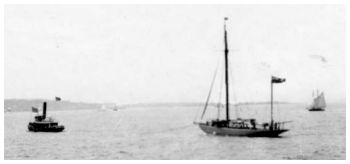 SHAMROCK AU PORT APRÈS UNE TRAVERSÉE RAPIDE
SHAMROCK AU PORT APRÈS UNE TRAVERSÉE RAPIDE 19 août 1899 : L’arrivée du challenger de la coupe Shamrock a créé une surprise en Amérique. Prévue au plus tôt la semaine prochaine,...
19 août 1899 : L’arrivée du challenger de la coupe Shamrock a créé une surprise en Amérique. Prévue au plus tôt la semaine prochaine,...
... il a passé le Hook tôt hier matin, quatorze jours, dix-neuf heures et cinquante-quatre minutes après son départ de Fairlie en Écosse. Ce fut un voyage record pour un challenger de la Coupe, mais il a été remorqué environ un tiers du parcours. Il faisait un temps humide et brumeux à la mode anglaise du Channel lorsque Shamrock et le yacht à vapeur Erin ont passé la baie inférieure et les Narrows, mais le port était éveillé, et les navires à vapeur ont donné au challenger un accueil royal avec leurs sirènes.
| LAT. | LONG. | DIST | |
| Aug. 4 | 53° 10' | 04° 52' | 203 |
| Aug. 5 | 51° 03' | 10° 02' | 263 |
| Aug. 6 | 48° 13' | 16° 25' | 282 |
| Aug. 7 | 46° 28' | 21° 00' | 223 |
| Aug. 8 | 44° 29' | 24° 36' | 193 |
| Aug. 9 | 42° 20' | 27° 49' | 190 |
| Aug. 10 | 39° 48' | 31° 21' | 243 |
| Aug. 11 | 39° 13' | 37° 10' | 263 |
| Aug. 12 | 38° 44' | 42° 00' | 231 |
| Aug. 13 | 38° 13' | 47° 31' | 266 |
| Aug. 14 | 38° 52' | 53° 41' | 290 |
| Aug. 15 | 39° 16' | 59° 05' | 258 |
| Aug. 16 | 39° 23' | 63° 36' | 210 |
| Aug. 17 | 40° 07' | 69° 14' | 265 |
| Aug. 18 | Arrived Sandy Hook 8:14 A. M. |
216 | |
| Total : 3,596 | |||
Les yachts ont rencontré à vingt-cinq miles à l'est de Sandy Hook Lightship le remorqueur Robert Hadden qui patrouillait au large pour un remorquage. Le remorqueur James A. Lawrence affrété par David Barrie, l'agent de Sir Thomas Lipton, n’était pas dans les parages car M. Barrie ne supposait pas que le yacht avait encore atteint les Açores où il est passé sans être signalé il pensait qu'il n'arriverait pas ici avant le 25 août
Les bateaux ont passé le Hook à 08:14 et sont arrivés à la Quarantaine à 9:45. Ils ont été abordés par le l'officier général de la Santé, L'Hommedieu, et, comme le capitaine Hogarth du Shamrock et le Capt Matthews de l'Erin a rapporté que tout allait bien, ils sont passés rapidement et sont allés mouiller au large de Tompkinsville.
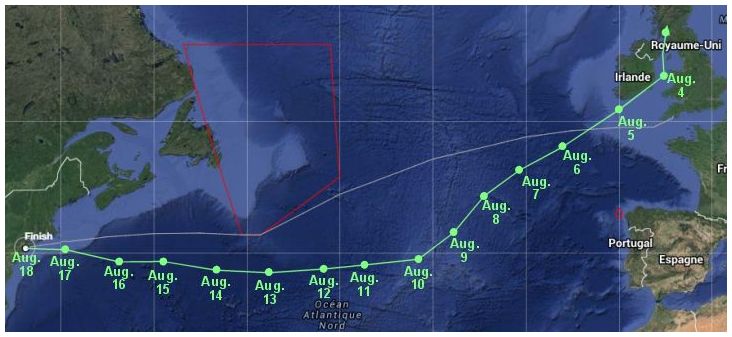
Dr. Mackay consented to give an account of the voyage across, as Capt. Matthews of the Erin turned in for a sleep as soon as he got things to rights, having been up for nearly forty-eight hours on account of the fog. The doctor, an Edinburgh University man, showed that he knew something of the sea, and he outlined the trip with more color than the abstract of the log contains.
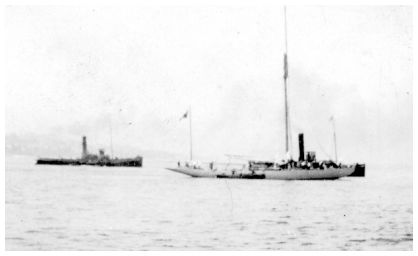 The Shamrock left Greenock, where she fitted out, Aug. 2, and dropping down the Clyde waited a day for the start. Favorable winds were in evidence, and the Shamrock went past the Isle of Man with all sails set, and rounded the south coast of Ireland. Brow Head was signaled that all was well aboard. The reply was “Success to you.”
The Shamrock left Greenock, where she fitted out, Aug. 2, and dropping down the Clyde waited a day for the start. Favorable winds were in evidence, and the Shamrock went past the Isle of Man with all sails set, and rounded the south coast of Ireland. Brow Head was signaled that all was well aboard. The reply was “Success to you.”
The Shamrock, with mainsail, topsail, forestaysail, and jib, came on, on her Western course, at a ten-knot gait, and everything went smoothly until Aug. 6. Then the weather became cloudy and unsettled, and sheet lightning that was blinding prevailed that day. Up to the 8th moderate seas prevailed, but then heavy weather set in, accompanied by a fog in which the Erin lost sight of the Shamrock. Heavy seas swept over the decks of the Erin, and it was afterward learned that Shamrock was equally deluged. On the morning of the 9th the Erin picked up the Shamrock, and Capt. Matthews figured that they were then 225 miles from Corvo, in the Azores.
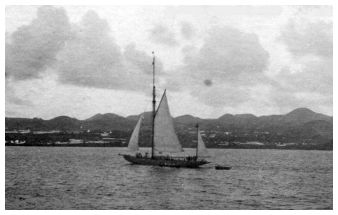 When the Shamrock was overhauled she had her jib set, and, after exchanging greetings, it was found that all was well aboard the sloop. Before sailing, arrangements had been made for both vessels to call at Fayal in case they lost each other. After the exchange of greetings the Shamrock signaled, “Do you intend to call anywhere?” Capt. Matthews immediately answered “No," and the sloop sailed on with all sails set. Pleasant weather was experienced that evening and during the night. At 9:35 o'clock on the morning of the 10th both vessels sighted Corvo, at a distance of ten miles, but did not signal the land. The navigator on board the Erin calculated that his vessel had gone about 1,559 miles. Both vessels were going at about the rate of 11½ knots an hour. On the 11th a dead calm was experienced, followed by head winds.
When the Shamrock was overhauled she had her jib set, and, after exchanging greetings, it was found that all was well aboard the sloop. Before sailing, arrangements had been made for both vessels to call at Fayal in case they lost each other. After the exchange of greetings the Shamrock signaled, “Do you intend to call anywhere?” Capt. Matthews immediately answered “No," and the sloop sailed on with all sails set. Pleasant weather was experienced that evening and during the night. At 9:35 o'clock on the morning of the 10th both vessels sighted Corvo, at a distance of ten miles, but did not signal the land. The navigator on board the Erin calculated that his vessel had gone about 1,559 miles. Both vessels were going at about the rate of 11½ knots an hour. On the 11th a dead calm was experienced, followed by head winds.
The Erin took the Shamrock in tow, and during part of the 11th, 12th, and 13th of August she towed the sloop, which, however, carried all her sails. A slight breeze from the north-northeast was then in evidence, and this continued until the 15th. At noon on that date the Shamrock was leading, and the navigator calculated that they were about 641 miles east of Sandy Hook. A steady wind prevailed, and the cup challenger was going steadily at a ten-knot gait. On the 16th a heavy swell made both boats roll a good deal.
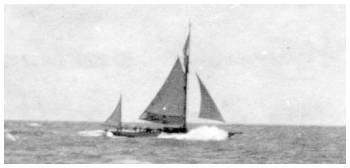 On the following day, Thursday, their approach to this shore was marked by the passing and signaling of out-bound craft, one of which was the America of the National Line. Early yesterday morning the Fuerst Bismarck was sighted, notwithstanding that a thick fog prevailed. At 7 o'clock Pilot Crocker boarded the Shamrock, and Pilot Bigley climbed aboard the Erin. From this until the vessels came to anchor nothing of any moment occurred with the exception of a rousing reception from all passing craft.
On the following day, Thursday, their approach to this shore was marked by the passing and signaling of out-bound craft, one of which was the America of the National Line. Early yesterday morning the Fuerst Bismarck was sighted, notwithstanding that a thick fog prevailed. At 7 o'clock Pilot Crocker boarded the Shamrock, and Pilot Bigley climbed aboard the Erin. From this until the vessels came to anchor nothing of any moment occurred with the exception of a rousing reception from all passing craft.
Besides Capt. Matthews, the Erin carries a first and a second officer, a chief engineer, and a crew of 58 men. The Shamrock has fifty-five men aboard according to Mr. Barrie, including Capt. Archie Hogarth, Capt. Wringe, and Navigator Hamilton. On the Erin there was but one passenger, the Chevalier de Martino, marine painter to the Queen, who was here on the occasion of the last cup races and has many friends in this country. He was at work in the cabin yesterday finishing up a drawing of the Shamrock in her yawl rig.
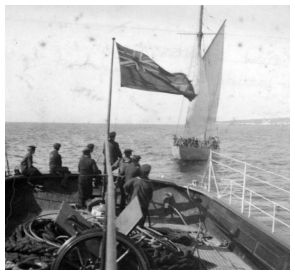 In connection with the time of the Shamrock's voyage, the following figures, showing what other cup challengers have done crossing the ocean, are recalled:
In connection with the time of the Shamrock's voyage, the following figures, showing what other cup challengers have done crossing the ocean, are recalled:
- Sir Richard Sutton's Genesta, sailing from Queenstown June 23, 1885, crossed in twenty-two days;
- Lieut. W. Henn’s Galatea sailing from Plymouth June 30, 1886, and thirty-one days to Marblehead, Mass.
- Commodore Bell’s Thistle, leaving Gourock July 25, 1887, arrived in twenty-two days. Returning she made it in seventeen days.
- Valkyrie II was 29 days 18 hours, coming to New York and 28 days returning in 1893.
- Valkyrie III sailing July 27, 1895, was 22 days coming west.
The old America crossed from New York to Havre in July, 1851, in 21 days; the Sappho, from New York to Falmouth, in 1868, in 14 days; the Henrietta, from New York to the Needles, in 1869, in 13 days 21 hours 55 minutes; the Cambria, in 1870, from Daunt’s Rock to Sandy Hook, in 22 days; the Livonia, in 1871, in 29 days; and the Vigilant crossed in 14 days 13 hours 41 minutes, in 1894, to the eastward, and 17 days 18 hours 50 minutes to the west in 1895.
